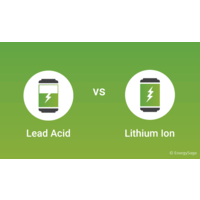Lead-acid vs. Lithium Battery Comparison

Lead-acid vs. Lithium Battery Comparison
Lead-acid batteries cost less up front, but they have a shorter lifespan and require regular maintenance to keep them running properly. Lithium batteries are much more expensive up front, but they are maintenance-free and have a longer lifespan to match their higher price tag. This article offers a side-by-side comparison of both options.
4 Key Differences Between Lead-acid and Lithium Batteries
1. Cycle life
- When you discharge a battery (use it to power your appliances), then charge it back up with your panels, that is referred to as one charge cycle. We measure the lifespan of batteries not in terms of years, but rather how many cycles they can handle before they expire.
- Think of it like putting mileage on a car. When you evaluate the condition of a used car, mileage matters a lot more than the year it was produced.
- Cycle life is also a function of depth of discharge (how much capacity you use before recharging a battery). Deeper discharges put more stress on the battery, which shortens its cycle life.
2. Depth of Discharge
- Discharge depth refers to how much overall capacity is used before recharging the battery. For example, if you use a quarter of your battery’s capacity, the depth of discharge would be 25%.
- Batteries don’t discharge fully when you use them. Instead, they have a recommended depth of discharge: how much can be used before they should be refilled.
- Lead-acid batteries should only be run to 50% depth of discharge. Beyond that point, you risk negatively affecting their lifespan.
- In contrast, lithium batteries can handle deep discharges of 80% or more. This essentially means they feature a higher usable capacity.
3. Efficiency
- Lithium batteries are more efficient.
- As an example, lead acid batteries are only 80-85% efficient depending on the model and condition. That means if you have 1,000 watts of solar coming into the batteries, there are only 800-850 watts available after the charging and discharging process.
- Lithium batteries are more than 95% efficient. In the same example, you’d have over 950 watts of power available.
- Higher efficiency means your batteries charge faster. Depending on the configuration of your system, it could also mean you buying fewer solar panels, less battery capacity and faster recharge time.
4. Charge Rate
- With higher efficiency also comes a faster rate of charge for lithium batteries. They can handle a higher amperage from the charger, which means they can be refilled much faster than lead-acid.
- We express charge rate as a fraction, such as C/5, where C = the capacity of the battery in amp hours (Ah). So a 430 Ah battery charging at a rate of C/5 would receive 86 charging amps (430/5).
- Lead-acid batteries are limited in how much charge current they can handle, mainly because they will overheat if you charge them too quickly. In addition, the charge rate gets significantly slower as you approach full capacity.
- Lead acid batteries can charge around C/5 during the bulk phase (up to 85% capacity). After that, the battery charger automatically slows down to top off the batteries. This means lead acid batteries take longer to charge, in some cases more than 2x as long as a Lithium alternative.
We hope this helps you when you come across products that look the same but have different price tags.

